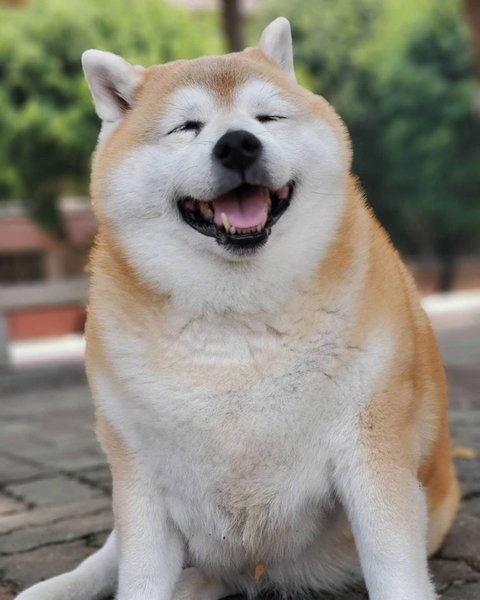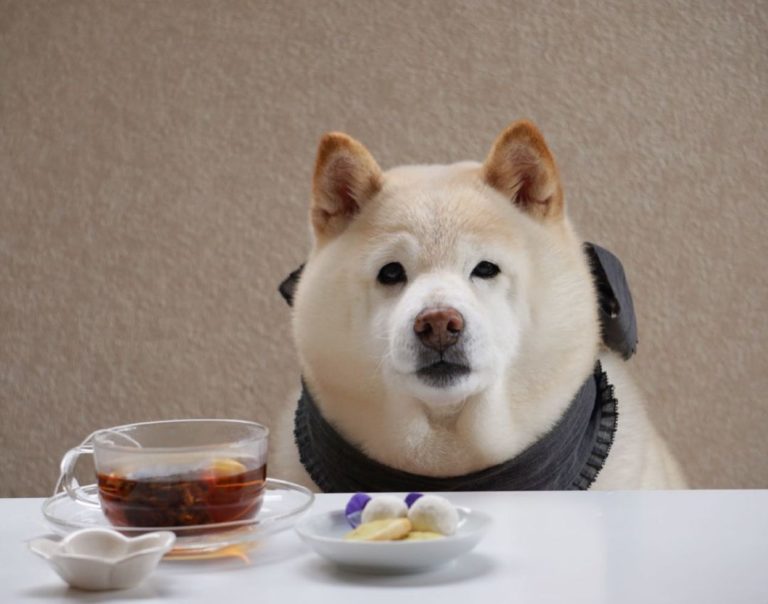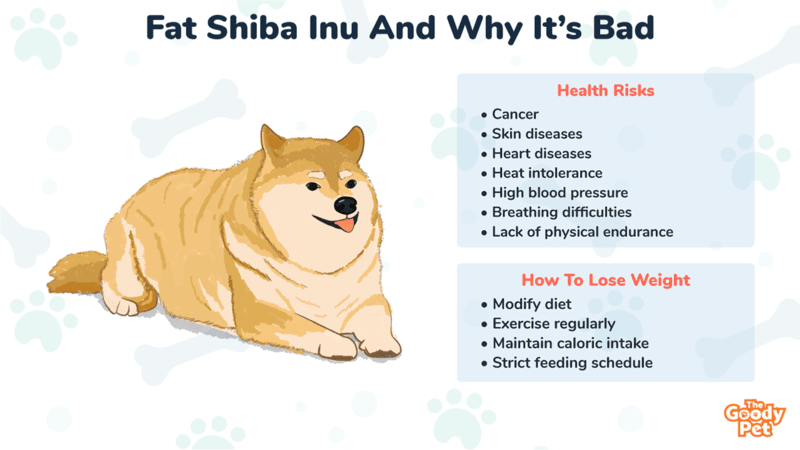Fat Shiba Inus are becoming something of a trend nowadays, but by encouraging your furry friend to gain excessive weight, you’re only putting the pooch in danger of suffering from several health complications. So, how can you tell that your Shiba Inu is overweight?
You can tell whether or not your Shiba Inu is overweight by feeling around the pooch’s body for the pooch’s skeletal structure. An inability to feel a Shiba Inu’s ribs even after pressing hard on the pooch suggests that the pooch is overweight, and necessary measures should be taken to correct the dog’s weight.
Once it has been determined that your Shiba Inu is overweight, you should immediately swing into action to regulate the pooch’s size and counter the development of weight-related health issues. That said, feeling around a Shiba Inu’s body is just one of the ways to tell whether or not the pooch is overweight, and the other methods by which you can gauge a Shiba’s weight are outlined in the section below.
How Do I Know If My Shiba Inu Is Overweight?
You can determine whether or not your Shiba Inu is overweight by carrying out a simple physical examination of the pooch’s body.
In addition, by measuring and comparing your Shiba Inu’s weight to the breed standard, you can also tell whether or not your pooch’s weight is healthy.
Carrying Out A Simple Physical Examination
One of the simplest and most commonly adopted means of gauging whether or not a Shiba Inu’s weight is healthy is by feeling around and carrying out a simple visual check of the pooch’s body.
Healthy Shiba Inus should have a defined waistline towards the rear and a straight build by the sides. But if you notice that your pooch has a round or oval shape, then it is most likely overweight. In addition, when you examine an overweight Shiba Inu from the side, you can typically notice the presence of a sagging waist or a swinging stomach.
Vets also recommend feeling your Shiba Inu’s rib cage to determine whether or not the pooch is overweight. If you can feel your Shiba Inu’s ribs without having to press hard, then the pooch is physically fit.
However, if you’re unable to feel the Shiba Inu’s ribs even after pressing hard, this implies that there’s excess fat getting in the way, and the Shiba Inu is most likely overweight.
Observing Your Dog’s Behavior
You can promptly determine whether or not your Shiba Inu is overweight by paying close attention to the pooch’s behavior around the home.
Expectedly, and for obvious reasons, if a Shiba Inu is overweight, the pooch will typically slow down and spend most of the time lazily lounging around the home. In the same vein, walking difficulties and breathing problems can also indicate that Shiba Inu has put on more weight than normal.
Comparing Your Shiba Inu’s Weight To The Breed Standard
By weighing your Shiba Inu with a special doggie scale at home or when you visit your vet and comparing its weight to the breed standard, you can decide whether or not the pooch is overweight.
Generally, a six-month-old Shiba Inu should weigh between 12 to 17 lbs. And when fully grown (around one year of age), the ideal weight for a male Shiba Inu typically falls between 18 to 24 lbs, and adult female Shiba Inus, with weights ranging between 16 to 19 lbs, are typically smaller.
Weight values higher than the ranges provided above suggest that your Shiba Inu is overweight, and this can be potentially dangerous to the pooch.
What Happens If Your Shiba Inu Gets Overweight?
There are several health risks associated with letting your Shiba Inu gather excess weight, and these can be very detrimental to your pooch’s overall wellbeing. Accordingly, you can expect obesity and weight-related issues to shed off at least two years from an overweight Shiba Inu’s lifespan.
That said, some of the health challenges that an overweight Shiba Inu is prone to suffering from include:
- Breathing difficulties
- Heart diseases
- Heat intolerance
- Lack of physical endurance
- Skin diseases
- Cancer
- High blood pressure
- Lameness

How Much Is A Shiba Inu Supposed To Eat?
The amount of food a Shiba Inu is supposed to eat is heavily influenced by the pooch’s age, size, activity levels, and caloric content of the food product.
How Much Should You Feed A Shiba Inu Puppy?
Generally, Shiba puppies are at an early stage of development and will require constant nutrition for healthy growth and physical development. Hence, Shiba Inu puppies need small-sized portions of food and frequent feeding for the first few months of their lives as they make the switch from their mother’s milk to solid dog food.
It is advisable to leave food out at all times for Shiba Inu puppies till they clock four months of age, after which their meals should be divided into three portions per day. And as Shiba puppies grow older, they graduate to being fed twice daily.
Dividing a Shiba Inu puppy’s meals into portions like this helps the pooch maintain energy levels throughout the day, and it also makes food easier to digest for the pup.
How Much Should You Feed An Adult Shiba Inu?
Adult Shiba Inus, in contrast, have attained physical maturity and just need enough calories to get enough energy to go about their physical activities. Hence, most adult Shiba Inu dogs will do well with being fed twice daily.
A general guideline to meeting a Shiba Inu’s calorie requirements according to weight and, by extension, age is given below:
[ 13.636 X Weight (lbs) + 70 ] calories per day
Hence, if your Shiba Inu weighs 17.6 lbs, it will typically need to consume:
( 13.636 X 17.6 ) + 70 = approx. 310 calories of food per day
As mentioned, this method of evaluation is meant to serve as a guideline, and the amount of food your Shiba Inu will consume daily is largely dependent on factors such as:
- The pooch’s activity level
- Lifestyle
- Personal preference
- Physical conditioning
- Health status
For more guidance on how much you should feed your Shiba Inu, it can also be helpful to check out the label instructions of whatever food product you’re giving to the pooch.
What Should You Feed A Shiba Inu?
Feeding a Shiba Inu with a diet of appropriate nutritional requirements is important to prevent weight-related issues and ensure the pooch lives a long, healthy life.
The ideal healthy meal for a Shiba Inu is one that offers protein as its major source of nutrition. And it is equally important that this protein is gotten from a meat source such as chicken, turkey, or beef, among others.
Carbohydrates and healthy fats are also essential in sustaining a Shiba Inu’s active lifestyle, and along with vitamins and minerals, should be included in the pooch’s diet.
Shiba Inus thrive well on either dry kibble, wet meals, a raw diet, or homemade food. And regardless of whichever food product you decide to feed your Shiba Inu with, you should examine the said product’s ingredients and ensure that you’ll be providing the pooch with great nutritional value.

How Do I Get My Shiba Inu To Lose Weight?
You can get your Shiba Inu to lose weight by adopting a strict feeding schedule, feeding the pooch with smaller portions of food, and regularly engaging the doggie in physical activities.
Determine The Cause Of Your Shiba’s Weight Gain
The first thing to do when you notice your Shiba Inu putting on the lbs is to try and determine the cause of the pooch’s excessive weight gain.
If you have multiple dogs at home, is your Shiba the greedy type that eats other dogs’ food? Or is your Shiba’s sudden weight gain due to an underlying medical condition?
Answering these questions and finding out what is responsible for your Shiba’s abnormally high weight will go a long way in devising ways to get the pooch to lose weight.
Modify Your Shiba’s Diet
You can stimulate a weight loss in your overweight Shiba Inu by making changes to the pooch’s feeding plans.
Giving your overweight Shiba Inu its regular dog food in the morning, switching to low sodium green beans for its second meal, and a doggie multivitamin for the pooch’s final meal of the day will work wonders in getting the Shiba to lose weight.
Food products with a high percentage of carbohydrates tend to make a Shiba Inu gain weight. Hence, it will be in your pooch’s best interests to switch to a high protein, low carbohydrate diet.
Treats are a sure-fire way of piling up the lbs, and you should reduce the amount of treats you feed to your Shiba Inu. You can also replace biscuits and other high-fat treats with fresh chopped carrots, apples, and products that are generally free of artificial flavoring.
Be Stricter With The Shiba Inu’s Feeding Schedule
Most dogs will continue eating for as long as the food is made available, and by adopting a free feeding method, you’re only encouraging your Shiba Inu to gain excess, unhealthy weight.
Feed the Shiba Inu only at specific, scheduled periods during the day. And whether or not the pooch finishes its meals within the stipulated period, withdraw its plate once the time is up.
Employ The Use Of Measuring Cups
If you’ve been pouring out food for your Shiba Inu without measuring, now’s the time to begin leaving out specific amounts of food for your overweight pooch.
Guidelines on how much to feed a Shiba Inu have been laid out in the previous section, but if you have an overweight Shiba, it will help to start by cutting down on the amount of food being fed to the pooch.
Maintain The Shiba’s Caloric Intake
While cutting down on the Shiba Inu’s meals, it is important that you avoid reducing the Shiba’s caloric intake as this will impact negatively on the pooch’s nutrition. And this can be achieved by feeding the pooch a well-balanced diet.
If you’re at a loss on how to provide the required nutrition for your Shiba Inu while cutting down on its meal size, we recommend feeding your pooch with the Pet Plate diet plan.
And since you’re dealing with an overweight Shiba Inu, Pet Plate’s food customization feature that encourages customers to submit their dogs’ unique physical characteristics and get a healthy custom-made diet in return will assist greatly in this weight loss project.
Increase Your Dog’s Physical Activities
Another way of getting your Shiba Inu to lose a significant amount of weight is by engaging the pooch in exercises and activities more frequently. Exercises help burn excess nutrition consumed by the Shiba Inu, thereby preventing it from being stored as fat in the pooch’s body.
Thankfully, the Shiba Inu is an active and energetic dog by nature; hence, this pooch will typically have no objections to being put through its paces.
Encouraging your overweight Shiba to jog with you or go on walks for at least 20 to 25 minutes per day will go a long way in getting the pooch to lose weight.
Similarly, playing fetch with the iFetch Interactive Ball Launchers For Dogs with your overweight Shiba Inu not only gets the pooch to lose weight, but you’ll also be developing the pooch’s social skills in the process.
The iFetch ball launcher is fully automatic, which means your Shiba Inu can get some much-needed exercise, even in your absence! And with the ability to adjust the balls’ launching distances, you can also avoid putting your overweight Shiba through stress.
Seek Your Family’s Participation
This last point is often overlooked, but the importance of teamwork can’t be overstated in the mission to get an overweight Shiba Inu to lose some lbs.
Someone sneaking in treats and snacks to your overweight Shiba Inu while you’re on the quest to get the pooch to lose weight can be quite counterproductive and frustrating, to say the least. And it is safe to say that you won’t see much progress in your weight loss project.
That said, it is advisable that you involve your family members in your plans to get your Shiba Inu to lose weight and, if possible, get them to participate in the project with you.





